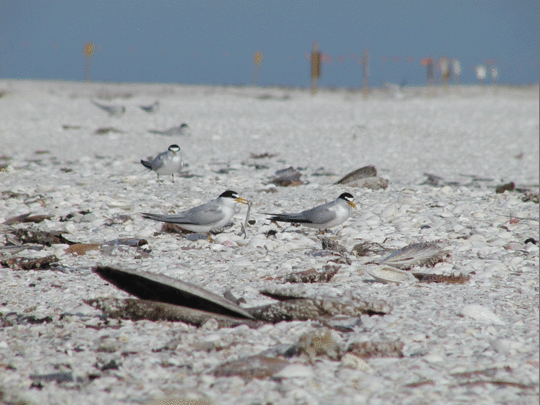FOR IMMEDIATE RELEASE: March 1, 2019
DEP's Rookery Bay Research Reserve and Partners Prepare for Nesting Season
~Partnership provides protection for threatened birds~
 As part of a cooperative effort with Audubon and FWC, the Second-Chance Sandbar is closed annually to protect shorebird nesting areas.
NAPLES, Fla. – The Florida Department of Environmental Protection's Rookery Bay National Estuarine Research Reserve, in collaboration with Audubon Florida and the Florida Fish and Wildlife Conservation Commission (FWC), is working to protect nesting habitat for least terns, black skimmers and Wilson's plovers at the Second-Chance Sandbar. Beginning March 1, the sandbar, which is designated as a Critical Wildlife Area (CWA) by the FWC, will be closed to allow for successful nesting of these beach-dependent species.
"DEP is excited to partner with Audubon and FWC on the closure of Second-Chance Sandbar, which will ensure that the habitat vital to visiting nesting birds is left undisturbed," said DEP Secretary Noah Valenstein. "This partnership is a great example of how we can come together to achieve more now for Florida's environment and the wildlife that call it home."
“Protecting this habitat during the nesting season increases the likelihood of successful breeding,” said Rookery Bay Reserve Director Keith Laakkonen. “Even though the sandbar changes shape from year to year, it continually serves as important habitat for nesting and resting birds."
“Audubon Florida and hundreds of rare coastal birds are looking forward to Second Chance Critical Wildlife Area being open exclusively for nesting birds,” said Dr. Marianne Korosy, director of bird conservation for Audubon Florida. “While Floridians and visitors flock to our beautiful beaches, shorebirds flock to protected places like Second Chance for the peace and privacy they need to raise their vulnerable fuzzy chicks to adulthood. We're excited to partner with Rookery Bay Reserve's Team Ocean volunteers to keep Second Chance safe for nesting birds.”
“For nesting birds, CWAs are lifesaving. When birds are disturbed during the critical nesting period, they often fly off their nests, leaving eggs or chicks vulnerable to the sun and predators. Repeated disturbance can lead to entire colonies abandoning a nesting site,” said Dr. Brad Gruver, leader of FWC’s Species and Conservation Planning section.
The area is located one mile southeast of Cape Romano and has been closed annually since 2001. People, pets and vessels are prohibited from entering the CWA during the closure period, per state rule 68A-19.005 F.A.C. Nesting areas will be monitored throughout the nesting season. Once the signs are removed on Aug. 31, and after the birds have left, boating visitors may return.
When visiting any beach with nesting activity, visitors should consider the following guidelines to share the shore with wildlife:
- Watch where you walk - be careful not to step on eggs or chicks.
- Respect posted areas and keep your distance from resting or nesting birds.
- Observe regulations pertaining to dogs.
- Be sure to dispose of your trash properly – place it in trash cans or take it home with you if none are available.
- If birds appear agitated, take flight or swoop at you, you're too close to their nest, so turn around or alter your route to avoid nesting areas.
Rookery Bay Research Reserve offers numerous recreational options throughout its 110,000 acres of coastal lands and waters. To learn more about Rookery Bay, please visit www.rookerybay.org.
To learn more about Florida's CWAs, visit MyFWC.com/CWA.
|